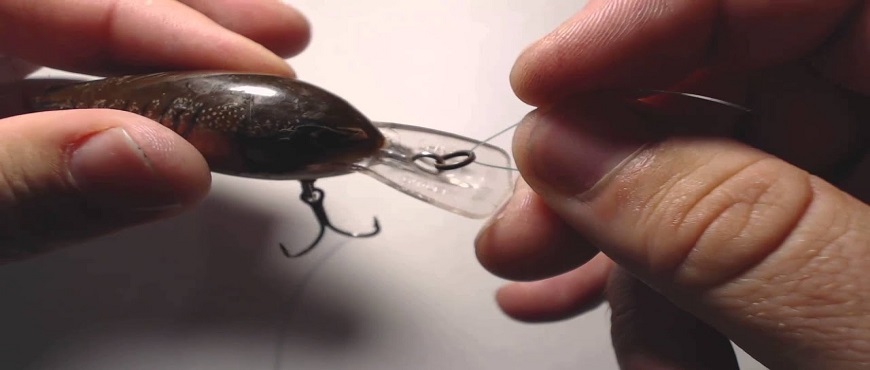How to Tie Crankbait : Easiest Tips and Tricks
To be good at angling, you have to have many different qualities. You cannot claim to be a skilled angler if you cannot tie a crankbait correctly. However, if you do not know how to tie crankbait, you still have a chance to learn how to do it appropriately.
Friends can help, but if you do not have the ones who can teach you, this guide offers you the chance to learn one of the most critical skills any angler can have. As a beginner who is out to learn new things and acquire fresh skills, this goal should be at the top of your list.
Contents
How Crankbaits Work
Crankbaits derive their name from the fact that they can float when you throw them in the water because you need to turn the crank for them to be effective.
A properly set crank provides action to the bait so that it starts to attract fish to it. Usually, there is a split ring at the top of the bait, and it provides you with the place to tie the lure.
Where Crankbait Is Used
Tying crankbait can be the easiest thing in the world and would barely take a minute. It is a very most common lure for fish that feed on smaller prey like baitfish and crayfish.
However, Crankbait is loved by bass anglers even more. As efficient as it may sound, crankbait is known to attract bass and would even present an almost 100 percent chance for catching the fish if you place the lures at the time when they feed.
So, if you have to tie it, make sure it will not slip underwater while battling with fish. The length, shape, and overall size of the lip of a crankbait determine how deep below the water surface it can go and how fast retrieval can be made.
Three Most Common Knots for Crankbait
1. Uni knot
This is the most suitable knot for newbies, and it the one that is the best choice for most fishing enthusiasts, including full beginner anglers. It is typically stronger, reliable, and amazingly effortless to tie. Mentioned below are all the steps you need to follow to tie a uni knot properly.
How to tie a uni knot
Start by setting the endpoint of your line through the hook’s eye. Next, turn the same end of that line back in the direction of the eye to create a loop. Now nip both strands, together with the crossing strand in one hand.
Use the remaining hand to wrap the end of the tag around the two strands of the line then into the loop. In this case, creating more wraps is better. Proceed to pull the end of the tag until these wraps form a loop that you can adjust.
Finally, complete the process by pulling the mainline such that it slides the knot to the hook’s eye. At this point, you will have done it, and your crankbait will be ready for an underwater experience.
2. Rapala knot
This knot is best suited for the kind of lure that vibrates or wobbles. Crankbaits such as lipped crankbaits vibrate or wobble a lot underwater, which is how they function. The more the vibration or wobbling occurs, the more they attract fish.
This is where the Rapala knot comes in because it creates more space for the wobbling or vibration of the crankbait. That means there will be more bites as well.
How to create Rapala knots
To begin this process, pick a line and make a simple overhead knot while leaving enough space for a tag line, at least a few inches. Now take the end of the tag and place it into the split ring. After that, place the tag end into the loop that you already made.
Next, wrap it around and about the mainline about four to seven times. Keep the loop steady by pinching it. Finally, put the end of the tag through the existing loop while pulling the mainline together with the tag end simultaneously.
When you do this, the loop stops further sliding of the knot. You will also see that there is enough loop leaving enough room for crankbaits to vibrate.
3. Nonslip loop knot
This knot type is more suitable for angling into seagrass, weeds, or top water fishing. You will encounter this every so often, especially when fishing for basses. That is because bass love to hide and often stays in very nasty covers with vegetation and seaweeds.
One of the things that make the nonslip loop knot the best for situations like this is that the end of its tag faces the lure. This ensures that no fragments snags with your line at all.
As you will see, this knot is relatively easy to prepare, boasts a superior breaking strength, and does not have any weed snagging difficulty.
How To Tie Nonslip Loop Knots
Create a simple overhead loop first, then pull the tag’s end of the line into the lure’s eye. Now pull the tag end into the lower side of the overhand loop. Next, make about three to four wraps as firmly as possible with the end of the tag around its mainline.
At this point, pull the end of the tag back into the loop. To complete the process, wet the knot by applying some water and leaving the tag's end. Finally, snap the knot by pulling the mainline tight before you cut the end of the tag.
Final Verdict
Now that you know how to tie crankbait, you can reap big with every fishing session. Crankbaits are also preferred by anglers looking for an option that allows them to fish in various depth zones or cover large areas quickly. Although you can find them in various colors, shapes, and sizes, their greatest defining feature is the lure bill.
That is what determines whether they are shallow, medium, or deep-diving plugs. The best choice you can get is the shallow water crankbait with square bills. Once you have it right, you should go ahead and make the most out of it in the water.
You May Also Read – Top 10 Fish finder for shallow water

